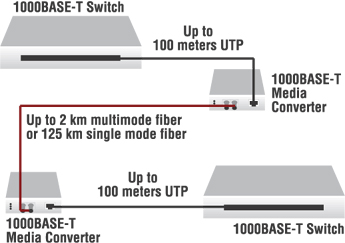|
Standards
|
IEEE
Std.
802.3ab™
and IEEE
Std.
802.3™
|
|
Fiber
Optic
Connector
Specs
|
|
Multimode |
|
ASGETF1013-110 |
Min TX
PWR:
-10.0
dBm
Max TX
PWR:
-4.0 dBm
RX
Sensitivity:
-17.0
dBm
Max In
PWR: 0.0
dBm
Link
Budget:
7.00 dB |
|
ASGETF1024-110 |
Min TX
PWR:
-10.0
dBm
Max TX
PWR:
-3.0 dBm
RX
Sensitivity:
-17.0
dBm
Max In
PWR:
-3.0 dBm
Link
Budget:
7.00 dB |
|
ASGETF1039-110 |
Min TX
PWR:
-9.0 dBm
Max TX
PWR:
-4.0 dBm
RX
Sensitivity:
-17.0
dBm
Max In
PWR:
-3.0 dBm
Link
Budget:
8.00 dB |
|
Single
Mode |
|
ASGETF1014-110 |
Min TX
PWR:
-9.5 dBm
Max TX
PWR:
-3.0 dBm
RX
Sensitivity:
-20.0
dBm
Max In
PWR:
-3.0 dBm
Link
Budget:
10.50 dB |
|
ASGETF1015-110 |
Min TX
PWR:
-5.0 dBm
Max TX
PWR: 0.0
dBm
RX
Sensitivity:
-24.0
dBm
Max In
PWR:
-3.0 dBm
Link
Budget:
19.00 dB |
|
ASGETF1017-110 |
Min TX
PWR:
-2.0 dBm
Max TX
PWR: 3.0
dBm
RX
Sensitivity:
-24.0
dBm
Max In
PWR:
-3.0 dBm
Link
Budget:
22.00 dB |
|
ASGETF1029-110 |
Min TX
PWR:
-8.0 dBm
Max TX
PWR:
-3.0 dBm
RX
Sensitivity:
-21.0
dBm
Max In
PWR:
-3.0 dBm
Link
Budget:
13.00 dB |
|
SGETF1029-111 |
Min TX
PWR:
-8.0 dBm
Max TX
PWR:
-3.0 dBm
RX
Sensitivity:
-21.0
dBm
Max In
PWR:
-3.0 dBm
Link
Budget:
13.00 dB |
|
ASGETF1029-112 |
Min TX
PWR:
-3.0 dBm
Max TX
PWR: 2.0
dBm
RX
Sensitivity:
-23.0
dBm
Max In
PWR:
-3.0 dBm
Link
Budget:
20.00 dB |
|
ASGETF1029-113 |
Min TX
PWR:
-3.0 dBm
Max TX
PWR: 2.0
dBm
RX
Sensitivity:
-23.0
dBm
Max In
PWR:
-3.0 dBm
Link
Budget:
20.00 dB |
|
ASGETF1029-116 |
Min TX
PWR:
-2.0 dBm
Max TX
PWR: 3.0
dBm
RX
Sensitivity:
-26.0
dBm
Max In
PWR:
-3.0 dBm
Link
Budget:
24.00 dB |
|
ASGETF1029-117 |
Min TX
PWR:
-2.0 dBm
Max TX
PWR: 3.0
dBm
RX
Sensitivity:
-26.0
dBm
Max In
PWR:
-3.0 dBm
Link
Budget:
24.00 dB |
|
ASGETF1035-110 |
Min TX
PWR: 0.0
dBm
Max TX
PWR: 5.0
dBm
RX
Sensitivity:
-27.0
dBm
Max In
PWR:
-3.0 dBm
Link
Budget:
27.00 dB |
|
6-position
Switch
|
SW1:
Remote
Fiber
Fault
Detect
(Down=Enabled)
SW2:
Symmetric
Pause
SW3:
Asymmetric
Pause
SW4:
Transparent
Link
Pass
Through
(UP=Enabled)
SW5:
Fiber
Auto-Negotiation
(Down=Enabled)
SW6:
Loopback
(Down=Enabled)
|
|
Status
LEDs
|
PWR
(Power):
Steady
green
LED
indicates
connection
to
external
AC power
RXF
(Fiber
receive):
Flashing
LED
indicates
reception
of data
on fiber
link
LKF
(Fiber
link):
Steady
LED
indicates
fiber
link
connection
RXC
(Copper
receive):
Flashing
LED
indicates
reception
of data
on
copper
link
LKC
(Copper
link):
Steady
LED
indicates
copper
link
connection
|
|
Dimensions
|
Width:
3.25"
[82 mm]
Depth:
4.8"
[122 mm]
Height:
1.0" [25
mm]
|
|
Power
|
External
AC/DC
required;
12V DC,
1.5A;
unregulated;
standard
|
|
Environment
|
0 – 50°
C
operating;
5% – 95%
humidity
non-condensing;
0 –
10,000
feet
altitude
|
|
Shipping
Weight
|
2 lbs.
[0.90
kg]
|
|
Safety
Compliance
|
Wall
Mount
Power
Supply:
UL
Listed,
C-UL
Listed
(Canada)
|
|
Regulatory
Compliance
|
FCC
Class A,
CISPR22/EN55022
Class A,
EN55024,
EN61000,
CE Mark
|
|
Warranty
|
Lifetime
|
